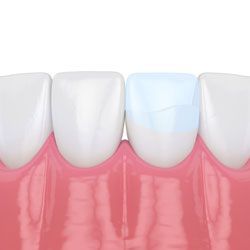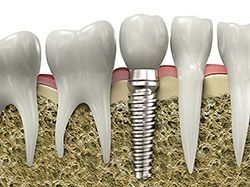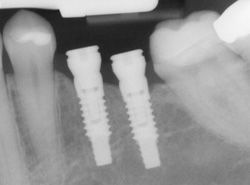Restore Your Oral Health With
Our Expert Restorative Dentistry
BONDING
Bonding is a conservative way to repair slightly chipped, discolored, or crooked teeth. During dental bonding, a white filling is placed onto your tooth to improve its appearance. The filling “bonds” with your teeth, and because it comes in a variety of tooth-colored shades, it closely matches the appearance of your natural teeth.

Tooth bonding can also be used for teeth fillings instead of amalgam fillings. Many patients prefer bonded fillings because the white color is much less noticeable than the silver amalgam fillings. Bonding fillings can be used on front and back teeth depending on the location and extent of tooth decay.
Bonding is less expensive than other cosmetic treatments and usually can be completed in one visit to our office. However, bonding can stain and is easier to break than other cosmetic treatments such as porcelain veneers. If it does break or chip, tell your doctor. The bonding generally can be easily patched or repaired in one visit.

EXTRACTIONS
There are times when it is necessary to remove a tooth. Sometimes, a baby tooth has misshapen or long roots that prevent it from falling out as it should, and the tooth must be removed to make way for the permanent tooth to erupt. At other times, a tooth may have so much decay that it puts the surrounding teeth and jaw at risk of decay, so your doctor may recommend removal and replacement with a bridge or implant. Infection, orthodontic correction, or problems with a wisdom tooth can also require the removal of a tooth.
When it is determined that a tooth needs to be removed, your dentist may extract the tooth during a regular checkup or may schedule another visit for this procedure. The root of each tooth is encased within your jawbone in a "tooth socket," and your tooth is held in that socket by a ligament. In order to extract a tooth, your dentist must expand the socket and separate the tooth from the ligament holding it in place. While this procedure is typically very quick, it is important to share with your doctor any concerns or preferences for sedation.
Once a tooth has been removed, neighboring teeth may shift, causing problems with chewing or with your jaw joint function. To avoid these complications, your dentist may recommend that you replace the extracted tooth.
BRIDGES
A bridge may be used to replace missing teeth, help maintain the shape of your face, and alleviate stress on your bite.
A bridge replaces missing teeth with artificial teeth, looks great, and literally bridges the gap where one or more teeth may have been. Your bridge can be made from gold, alloys, porcelain, or a combination of these materials and is bonded onto surrounding teeth for support.
The success of any bridge depends on its foundation — the other teeth, gums, or bone to which it is attached. Therefore, it's very important to keep your existing teeth, gums, and jaw healthy and strong.
CROWNS
Crowns are a cosmetic restoration used to strengthen a tooth or improve its shape. Crowns are most often used for teeth that are broken, worn, or partially destroyed by tooth decay.
Crowns are "cemented" onto an existing tooth and fully cover the portion of your tooth above the gum line. In effect, the crown becomes your tooth's new outer surface. Crowns can be made of porcelain, metal, or both. Porcelain crowns are most often preferred because they mimic the translucency of natural teeth and are very strong.
Crowns or onlays (partial crowns) are needed when there is insufficient tooth strength remaining to hold a filling. Unlike fillings, which apply the restorative material directly into your mouth, a crown is fabricated away from your mouth. Your crown is created in a lab based on your unique tooth impression, which allows a dental laboratory technician to examine all aspects of your bite and jaw movements. Your crown is then sculpted just for you so that your bite and jaw movements function normally once the crown is placed.
IMPLANTS
People are living longer than ever, and while regular brushing, flossing, and checkups allow many of us to maintain our natural smiles for a lifetime, sometimes our teeth just can't keep up. If you've lost a tooth (or a few teeth) due to injury or disease, dental implants can rejuvenate both your smile and your oral health.
An implant is a synthetic tooth root in the shape of a post that is surgically placed into the jawbone. The "root" is usually made of titanium: the same material used in many replacement hips and knees, and a metal that is well-suited to pairing with human bone. A replacement tooth is then fixed to the post. The tooth can be either permanently attached or removable. Permanent teeth are more stable and feel more like natural teeth.
The ideal candidate for implants is a non-smoker who has good oral health, including a sufficient amount of bone in the jaw and healthy gums with no sign of gum disease.
Our office features an in-house periodontist for placing implants. Dr. Rosario and our implant specialist will work together on implementing a permanent replacement for missing teeth.
SINGLE OR MULTIPLE IMPLANTS
Implants are versatile. If you are only missing one tooth, one implant plus one replacement tooth will do the trick. If you are missing several teeth in a row, a few strategically placed implants can support a permanent bridge (a set of replacement teeth). Similarly, if you have lost all of your teeth, a full bridge or full denture can be permanently fixed in your mouth with a strategic number of implants.
ADVANTAGES OVER DENTURES OR BRIDGES
Conventional bridges and dentures are not fixed to the bone and can, therefore, be unstable. This can make it difficult to eat or smile with confidence. Implants not only look more natural but also feel and act more like normal teeth, with a stronger biting force. And because they don't directly rely on neighboring teeth for support, implants don't compromise the health of your natural teeth. In fact, bridges are only expected to last seven to ten years, even less with root canals, whereas implants will typically last a lifetime.


IMPLANT-SUPPORTED DENTURES
Implant-supported dentures are over-dentures fixed to the bone by individual implants. For patients with an uncomfortable or loose-fitting denture, stabilizing it can be a more comfortable and functional solution.
Implant-supported dentures are placed in the jaw, where they are anchored firmly in the surrounding bone. Attachments are placed in the underside of the denture that connect to the implants. When placed in the mouth, the denture snaps onto the implants, keeping it stable and secure.
POST-TREATMENT CARE
Consider your replacement teeth to be the same as natural teeth. They require the same daily brushing and flossing and the same amount of regular checkups. Just like your natural teeth, the better you take care of your replacements, the longer they will last.
IMPLANT SERVICES
Our implant services include:
Sinus Lift Augmentation: Often, the sinuses will enlarge following the loss of the upper back teeth. This can preclude the placement of dental implants in the upper back areas of the mouth since the sinus is an air-filled space, and dental implants need to be surrounded by solid bone. A sinus lift augmentation/graft is a surgical procedure that restores the sinus cavity to its original size and replaces the bone that has been lost as a result of the enlarged sinus. This new bone graft typically takes nine to 12 months to heal before the dental implants can be placed into the grafted bone.
Autogenous Bone Grafting: Occasionally, the ideal areas for dental implants do not have sufficient bone quantity to support the implants. In these cases, it is often necessary to "borrow" bone from another area of your mouth and graft it into the deficient area. Often, the area of choice is from the chin or in the back of the jaw where your wisdom teeth used to be.
Implant Site Development: When a tooth needs to be removed due to infection, it is not uncommon to have lost bone around the infected tooth. In these cases, various types of bone grafting can be done at the same time the tooth is removed to facilitate the placement of a dental implant at a later date.
Computer-Enhanced Treatment Planning: We have special software on our computer that allows us to evaluate your dental CT scan in three dimensions for bone quality, bone quantity, and bone location, enabling the best possible placement of your dental implants. This also allows us to work closely and smoothly with your restorative dentist to ensure an ideal result where your dental implants are concerned.
Implant Maintenance: Once your dental implant restoration is completed, it is important to keep the area clean and infection-free. Dental implants can accumulate plaque and tartar just as teeth can. Whether you have just one tooth replaced by an implant or several, a professional cleaning schedule will be necessary to keep your implants healthy. The time interval for these professional cleanings will be determined by your individual needs.
DENTURES
Dentistry is all about smiles, and having a confident, healthy, beautiful smile is important even for patients wearing dentures. Our practice provides personalized denture services that meet the needs and comfort levels of our patients. All of our patients are unique, and we create one-of-a-kind dentures that feel good and look natural.
WHAT ARE DENTURES?
Dentures are natural-looking replacement teeth that are removable. There are two types of dentures: full and partial.
- Full dentures are given to patients when all of the natural teeth have been removed. Conventional full dentures are placed after the gum tissue has healed, which can take several months. Immediate full dentures are placed right after the teeth have been removed and may require frequent adjustments during the first couple of months of use.
- Partial dentures
are attached to a metal frame that is connected to your natural teeth and are used to fill in where permanent teeth have been removed. Partial dentures are considered a removable alternative to bridges.
HOW DO I KNOW IF DENTURES ARE THE RIGHT CHOICE FOR ME?
Dentures are not for everyone. If you're interested in learning more about dentures and want to know if they are the right choice for you, please schedule an appointment. Our team will be happy to answer any questions you might have and can determine the best course of treatment for your ongoing dental health.
CARING FOR YOUR DENTURES
Dentures, just like natural teeth, require daily maintenance to stay clean and keep bacteria from growing inside of your mouth. Keep your dentures clean and your smile healthy:
- When handling your dentures, stand over a clean, folded towel or a sink full of water. This way, if you accidentally drop your dentures, they are less likely to break.
- Your dentures are not immune from plaque and tartar build-up, so it's important that you brush your dentures every day. To brush your dentures, use a soft-bristled brush and gently brush the surfaces of the dentures, being careful not to break or bend the plastic. Between brushings, it's important to rinse your dentures after each meal.
- Use a gentle cleanser to clean your dentures. Many toothpastes, household cleaners, and mouthwashes can be too hard on your dentures, so it is recommended that you use a mild hand or dish soap to get your dentures clean. Be sure to check for the American Dental Association (ADA) seal of approval to choose products that are safe for your dentures, or ask your dentist about which products may be best for you.
- When you are not wearing your dentures, they need to be kept moist. Dentures that are not kept in a denture cleaning solution or in water can dry out, lose their shape, or even crack and break. Certain styles of dentures require certain soaking solutions, so be sure to ask your dentist which solution is best for you.
- Even if you have a full set of dentures, it's important to keep your gums and tongue clean. Be sure to use a soft-bristled brush to gently clean your gums and tongue every day.
If, by chance, your dentures break, please contact our practice and
schedule an appointment as soon as possible. Broken dentures that don't fit properly can cause irritation to your gums and mouth. Also, remember to continue scheduling regular dental checkups every six months to make sure that your smile stays healthy for many years to come.
EMERGENCY DENTAL CARE
If you experience a dental emergency, be sure to call our practice as soon as possible. If you need immediate attention after hours, call our emergency phone number, and our on-call staff member will help you. If you are unable to reach our office during an emergency, dial 911.
We are here to help you, any time, any day. When your dental health is at risk, we will do everything we can to make sure that you're treated as soon as possible. While dental emergencies are rare, they can happen, and it's important to know how to take care of your teeth no matter what.

Common dental emergencies include:
- Broken or cracked tooth/teeth
- Broken jaw
- Permanent tooth knocked out
- Object caught between teeth
- Severe toothache
TMJ-TMD
TEMPOROMANDIBULAR DISORDER (TMD)
Millions of Americans suffer from chronic facial and neck pain as well as recurring headaches. In some cases, this pain is due to Temporomandibular Disorder, or TMD.
Your temporomandibular joints (TMJ) connect your lower jawbone to your skull. These joints get a lot of use throughout the day as you speak, chew, swallow, and yawn. Pain in and around these joints can be unpleasant and may even restrict movement.
SYMPTOMS OF TMD INCLUDE:
- Pain in the jaw area
- Pain, ringing, or stuffiness in the ears
- Frequent headaches or neck aches
- Clicking or popping sound when the jaw moves
- Swelling on the sides of the face
- Muscle spasms in the jaw area
- A change in the alignment of the top and bottom teeth
- Locked jaw or limited opening of the mouth
Should you notice any of these symptoms, let your doctor know. Your dentist can help indicate the presence of TMD and create an effective treatment just for you.
There are a few simple steps you can take at home or work to prevent TMD from becoming more severe or to prevent it from occurring:
- Relax your face — remember the rule: "Lips together, teeth apart."
- Avoid grinding your teeth
- Avoid constant gum-chewing
- Don't cradle the phone receiver between your head and shoulder — either use a headset or hold the receiver in your hand
- Chew food evenly on both sides of your mouth
- Do not sit with your chin resting on your hand
- Practice good posture — keep your head up, back straight, and shoulders squared
SLEEP APNEA
Are you drowsy during the day with no explanation? Do you snore loudly or wake up breathless in the middle of the night? If you're experiencing any of these symptoms, you may be one of more than 12 million Americans who are affected by sleep apnea.
WHAT IS SLEEP APNEA?
Sleep apnea is a condition in which your breathing stops periodically during sleep, as many as 20-30 times per hour. Each time you stop breathing in your sleep, the resulting lack of oxygen alerts your brain, which temporarily wakes you up to restart proper breathing. Since the time spent awake is so brief, most people with sleep apnea don't remember it, and many believe they are getting a good night's sleep when, in fact, they are not. The constant wake-sleep, wake-sleep cycle prevents those with sleep apnea from achieving deep sleep, resulting in a constant drowsy feeling during the day.
WHAT ARE THE SIGNS OF SLEEP APNEA?
The following symptoms can indicate the presence of sleep apnea. If you notice one or more of these, contact our practice.
- Insomnia or difficulty sleeping
- Loud snoring at night
- Waking up at night short of breath
- Snorting or choking sounds during the night (indicating a restart of breathing)
- Headaches upon waking in the morning
- Falling asleep unintentionally during the day
- Extreme drowsiness throughout the day
ARE THERE DIFFERENT TYPES OF SLEEP APNEA?
There are three categories of sleep apnea. The most common is called obstructive sleep apnea (OSA), and occurs due to a physical blockage, usually the collapsing of the soft tissue in the back of the throat. Less common is central sleep apnea (CSA), in which breathing stops because the muscles involved don't receive the proper signal from the brain. And some people suffer from "mixed" or "complex" sleep apnea, which is a combination of obstructive and central.
WHAT ARE THE RISK FACTORS FOR SLEEP APNEA?
Obstructive sleep apnea is more common in males than females and more common in older adults (40+) than younger adults and children. However, anyone — regardless of gender or age — can suffer from sleep apnea. Other risk factors include obesity, smoking, drinking, use of sedatives or tranquilizers, and family history. Central sleep apnea strikes most often in people with heart disorders, neuromuscular disorders, strokes, or brain tumors.
IS SLEEP APNEA DANGEROUS?
Sleep apnea is considered a serious medical problem, and if left untreated, it can lead to high blood pressure, increasing the risk of heart failure and stroke. The ongoing state of fatigue caused by sleep apnea can lead to problems at work or school, as well as danger when driving or operating heavy machinery. Sleep apnea can also cause complications with medication or surgery; sedation by anesthesia can be risky, as can lying flat in bed after an operation. If you know or suspect you suffer from sleep apnea, let your family doctor know before taking prescribed medication or having surgery.
HOW IS SLEEP APNEA TREATED?
Treatments for sleep apnea depend on the severity of each individual case and the type of apnea. Basic treatment can be behavioral — for instance, patients are instructed to lose weight, stop smoking, or sleep on their sides instead of on their backs. Beyond that, oral devices can be used to position the mouth in such a way that prevents throat blockage. In more severe cases, surgery may be the best option.
WHAT SHOULD I DO IF I SUSPECT THAT SOMEONE IN MY FAMILY SUFFERS FROM SLEEP APNEA?
Contact our practice to determine if you have mild sleep apnea. If so, we're able to make a removable sleep apnea device you'll wear at night. More severe cases may be referred to a sleep apnea specialist. The specialist may recommend a sleep study to diagnose the precise extent of the problem, and can prescribe appropriate treatment.
PERIODONTAL TREATMENTS
TREATMENT OPTIONS
If you've been diagnosed with gum disease, there are a variety of treatment options depending on the details of your situation and the severity of the problem. We always start with the least invasive options, which are non-surgical. However, in more serious cases, surgery may be necessary.
NON-SURGICAL TREATMENT
The first line of defense against gum disease is a unique type of cleaning called "scaling and root planing." In this procedure, an ultrasonic cleaning device is used to remove plaque and tartar from your teeth where regular cleaning devices can't reach: under the gum line, on the tooth, and around the root. Then, the rough surface of the tooth and the root are smoothed out (planed). This provides a healthy, clean surface that makes it easier for the gum tissue to reattach to the tooth.
If you address your gum disease before it becomes severe, scaling and root planing may be the only treatment you need. However, as with any dental procedure, after-care is vital. In order to keep your teeth in good shape and resist future occurrences of gum disease, you must brush and floss daily, eat a healthy diet, avoid tobacco use, and have regular dental checkups. Even after a successful scaling and root planing, if you don't attend to your teeth properly, it's quite likely that you'll develop gum disease again.
SURGICAL TREATMENT OPTIONS
If the tissue or bone surrounding your teeth is too damaged to be repaired with non-surgical treatment, several surgical procedures are available to prevent severe damage and to restore a healthy smile. We will recommend the procedure that is best suited to the condition of your teeth and gums. Following is a list of common types of periodontal surgery:
Pocket Depth Reduction
In a healthy mouth, the teeth are firmly surrounded by gum tissue and securely supported by the bones of the jaw. Periodontal disease damages these tissues and bones, leaving open spaces around the teeth that we call pockets. The larger these pockets are, the easier it is for bacteria to collect inside them, leading to more and more damage over time. Eventually, the supportive structure degrades to the point that the tooth either falls out or needs to be removed.
During pocket reduction procedures (also known as "flap surgery"), we fold back the gum tissue and remove the bacteria hiding underneath, as well as the hardened plaque and tartar that have been collected. We may also remove any tissue that is too damaged to survive. We then sew the healthy tissue back into place. Now that the tooth and root are free of bacteria, plaque, and tartar, and the pockets have been reduced, the gums can reattach to the teeth.
Regeneration
When the bone and tissue supporting the teeth have been lost due to severe gum disease, we can restore these areas with a regeneration procedure. During this process, we begin by folding back the gum tissue and removing the bacteria, plaque, and tartar. Depending on your situation, we may then perform a bone graft to stimulate new bone growth, or we may apply a special kind of protein that stimulates tissue growth to repair the areas that have been destroyed by the disease.
Soft-Tissue Graft
A frequent symptom of gum disease is gum recession (also called gingival recession). As the gums recede, more of the roots are revealed. This can make teeth appear longer and can also create sensitivity to hot or cold liquids or food. It also exposes the tooth to increased damage from gum disease, as bacteria, plaque, and tartar attack the surface of the tooth and the root.
During a soft-tissue graft, tissue from the top of your mouth or another source is sewn to the gum area, covering the roots and restoring the gum line to its original, healthy location. This procedure can also be performed for cosmetic reasons.






